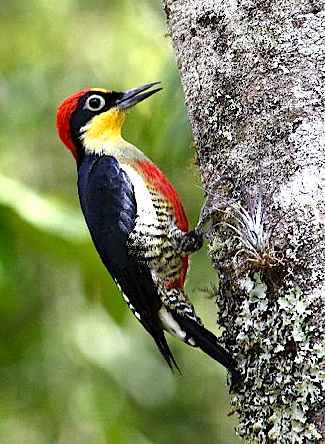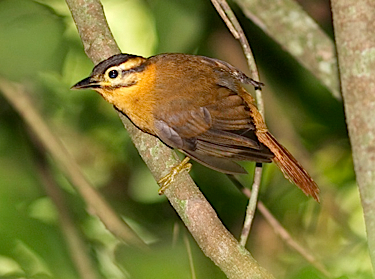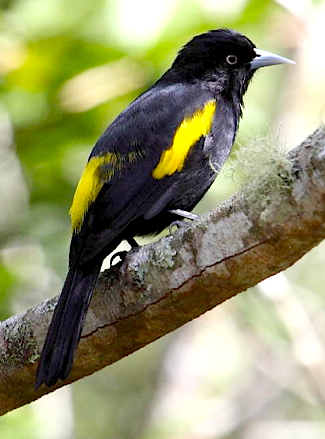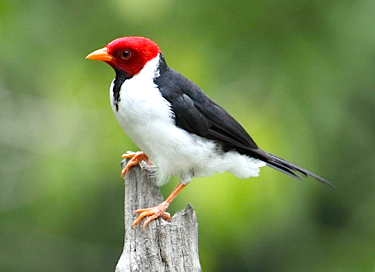For our tour description, itinerary,
past triplists, dates, fees, and more, please VISIT OUR TOUR PAGE.
See this triplist in printable PDF format with media only on
page 1.

En route to
Intervales on our first morning afield, we were treated to
point-blank views of this marvelous pair of Streamer-tailed
Tyrants displaying near the road! (Photo by guide Marcelo
Padua)
This year's Brazil Nutshell was a wonderful and very birdy
tour. We began with an important addition, guide John Coons,
whom I had met previously on several occasions but with whom
I'd never led a tour. It was great having him along, and we
owe several brilliant scope views of birds to him. I can
hardly wait to do this tour with him again next year! The
weather was also kind to us, and we had only one morning of a
travel day where the rain was somewhat inconvenient, but we
were awarded with sunshine for most of the trip.
Unfortunately, that was also the reason why the Pantanal was
so dry, the driest I have ever seen it in the month of March.
We started the tour in Sao Paulo with all participants
arriving on time with all their luggage (always a relief for
the leader!). From there we made our way to Intervales, but
not without making a few stops, including one that produced
some of the best views I've ever had of displaying
Streamer-tailed Tyrants. Upon reaching our lodge and just
getting into our rooms, a pair of Blue-bellied Parrots flew by
and sat on a nearby tree allowing us fantastic scope views of
these rare and endangered parrots. What a way to start the
tour! The following days at Intervales were nothing but a
birding delight, with four different species of tapaculos, one
great look at four Black-fronted Piping-Guans, Saffron
Toucanets, Black-cheeked and Rufous gnateaters,
Chestnut-backed and Brassy-breasted tanagers, and so many
others that made for a fun, productive, and memorable start to
the tour.
At Iguassu, the falls were, as always, the highlight, but the
birding was not far behind. We had wonderful looks at
Creamy-bellied Gnatcatcher, Southern Bristle-Tyrant, Southern
Antpipit, and Rufous-headed Tanager, and we located a
hummingbird feeder where we had amazing looks at ten different
species of hummers in just over an hour, not to mention the
Green-headed Tanagers and euphonias coming to the feeder as
well. I think we were all a bit dizzy and amazed by the time
we left that place!
The Pantanal lived up to its reputation and even though it
was drier than we had expected, the birding was magnificent,
with Hyacinth Macaws, Jabirus, Roseate Spoonbills,
Yellow-billed Cardinals, and more Limpkins than we could (or
wanted to!) count. We made our way through the Pantanal from
one Jabiru to the next with a Mato Grosso Antbird, a
Rusty-backed Spinetail, and even a Pale-crested Woodpecker in
between. Not a bad way to travel!
I thoroughly enjoyed this tour and hope you all did too. I'm
looking forward to seeing you again on one of our many Brazil
tours.
-Marcelo
For more information about this tour, including future
departures, visit our website at www.fieldguides.com.
And to see this same triplist online, go to https://fieldguides.com/triplists/nut12LIST.pdf
and you will find the list in its entirety.
KEYS FOR THIS LIST
One of the following keys may be shown in brackets for
individual species as appropriate: * = heard only, I =
introduced, E = endemic, N = nesting, a = austral migrant, b =
boreal migrant
Rheidae (Rheas)
GREATER RHEA (Rhea americana)
Tinamidae (Tinamous)
BROWN TINAMOU (Crypturellus obsoletus) [*]
UNDULATED TINAMOU
(Crypturellus undulatus) [*]
Anhimidae (Screamers)
SOUTHERN SCREAMER (Chauna torquata)
Anatidae (Ducks, Geese, and Waterfowl)
WHITE-FACED WHISTLING-DUCK (Dendrocygna viduata)
BLACK-BELLIED
WHISTLING-DUCK (Dendrocygna
autumnalis)
MUSCOVY DUCK
(Cairina moschata)
Cracidae (Guans, Chachalacas, and
Curassows)
CHACO CHACHALACA (Ortalis canicollis)
DUSKY-LEGGED GUAN
(Penelope obscura)
CHESTNUT-BELLIED
GUAN (Penelope ochrogaster)
BLUE-THROATED
PIPING-GUAN (Pipile
cumanensis)
RED-THROATED
PIPING-GUAN (Pipile cujubi)
BLACK-FRONTED
PIPING-GUAN (Pipile jacutinga)
[E]
BARE-FACED
CURASSOW (Crax fasciolata)
Ciconiidae (Storks)
MAGUARI STORK (Ciconia maguari)
JABIRU (Jabiru mycteria)
WOOD STORK
(Mycteria americana)
Phalacrocoracidae (Cormorants and Shags)
NEOTROPIC CORMORANT (Phalacrocorax brasilianus)
Anhingidae (Anhingas)
ANHINGA (Anhinga
anhinga)
Ardeidae (Herons, Egrets, and Bitterns)
LEAST BITTERN (Ixobrychus exilis)
RUFESCENT
TIGER-HERON (Tigrisoma
lineatum)

The handsome
Yellow-fronted Woodpecker was a regular visitor to feeders
around the lodge at Intervales, and was just one of 15
species of woodpeckers seen (and another heard) on this
tour! (Photo by tour participants Steve and Alison
Wakeham)
COCOI HERON (Ardea cocoi)
GREAT EGRET
(Ardea alba)
SNOWY EGRET
(Egretta thula)
LITTLE BLUE HERON
(Egretta caerulea)
CATTLE EGRET
(Bubulcus ibis)
STRIATED HERON
(Butorides striata)
WHISTLING HERON
(Syrigma sibilatrix)
CAPPED HERON
(Pilherodius pileatus)
BLACK-CROWNED
NIGHT-HERON (Nycticorax
nycticorax)
Threskiornithidae (Ibises and Spoonbills)
WHITE-FACED IBIS (Plegadis chihi)
GREEN IBIS
(Mesembrinibis cayennensis)
BARE-FACED IBIS
(Phimosus infuscatus)
PLUMBEOUS IBIS
(Theristicus caerulescens)
BUFF-NECKED IBIS
(Theristicus caudatus)
ROSEATE SPOONBILL
(Platalea ajaja)
Cathartidae (New World Vultures)
BLACK VULTURE (Coragyps atratus)
TURKEY VULTURE
(Cathartes aura)
LESSER
YELLOW-HEADED VULTURE (Cathartes
burrovianus)
Pandionidae (Osprey)
OSPREY (Pandion
haliaetus)
Accipitridae (Hawks, Eagles, and Kites)
GRAY-HEADED KITE (Leptodon cayanensis)
PEARL KITE
(Gampsonyx swainsonii)
SNAIL KITE
(Rostrhamus sociabilis)
BLACK-COLLARED
HAWK (Busarellus nigricollis)
CRANE HAWK
(BANDED) (Geranospiza
caerulescens gracilis)
GREAT BLACK-HAWK
(Buteogallus urubitinga)
SAVANNA HAWK
(Buteogallus meridionalis)
ROADSIDE HAWK
(Buteo magnirostris)
SHORT-TAILED HAWK
(Buteo brachyurus)
Falconidae (Falcons and Caracaras)

The thundering
falls at Iguazu are always a highlight of the trip; the
birding here isn't bad either! (Photo by guide Marcelo
Padua)
BARRED FOREST-FALCON (Micrastur ruficollis) [*]
SOUTHERN CARACARA
(Caracara plancus)
YELLOW-HEADED
CARACARA (Milvago chimachima)
LAUGHING FALCON
(Herpetotheres cachinnans)
AMERICAN KESTREL
(Falco sparverius)
BAT FALCON
(Falco rufigularis)
Cariamidae (Seriemas)
RED-LEGGED SERIEMA (Cariama cristata)
Eurypygidae (Sunbittern)
SUNBITTERN (Eurypyga
helias)
Rallidae (Rails, Gallinules, and Coots)
GRAY-BREASTED CRAKE (Laterallus exilis) [*]
GRAY-NECKED
WOOD-RAIL (Aramides cajanea)
SLATY-BREASTED
WOOD-RAIL (Aramides saracura)
[E]
ASH-THROATED CRAKE
(Porzana albicollis) [*]
BLACKISH RAIL
(Pardirallus nigricans)
PURPLE GALLINULE
(Porphyrio martinica)
COMMON GALLINULE
(Gallinula galeata)
Heliornithidae (Finfoots)
SUNGREBE (Heliornis
fulica)
Aramidae (Limpkin)
LIMPKIN (Aramus
guarauna)
Charadriidae (Plovers and Lapwings)
PIED LAPWING (Vanellus cayanus)
SOUTHERN LAPWING
(Vanellus chilensis)
Recurvirostridae (Stilts and Avocets)
BLACK-NECKED STILT (WHITE-BACKED)
(Himantopus mexicanus melanurus)
Jacanidae (Jacanas)
WATTLED JACANA (Jacana jacana)
Scolopacidae (Sandpipers and Allies)
SPOTTED SANDPIPER (Actitis macularius)
SOLITARY SANDPIPER
(Tringa solitaria)
GREATER YELLOWLEGS
(Tringa melanoleuca)
LESSER YELLOWLEGS
(Tringa flavipes)
WHITE-RUMPED
SANDPIPER (Calidris
fuscicollis)
PECTORAL SANDPIPER
(Calidris melanotos)
Laridae (Gulls, Terns, and Skimmers)
LARGE-BILLED TERN (Phaetusa simplex)
Columbidae (Pigeons and Doves)
ROCK PIGEON (Columba livia)
PALE-VENTED PIGEON
(Patagioenas cayennensis)
PICAZURO PIGEON
(Patagioenas picazuro)
EARED DOVE
(Zenaida auriculata)
PLAIN-BREASTED
GROUND-DOVE (Columbina minuta)
RUDDY GROUND-DOVE
(Columbina talpacoti)
SCALED DOVE
(Columbina squammata)
PICUI GROUND-DOVE
(Columbina picui)
LONG-TAILED
GROUND-DOVE (Uropelia
campestris)
WHITE-TIPPED DOVE
(Leptotila verreauxi)
GRAY-FRONTED DOVE
(Leptotila rufaxilla)
VIOLACEOUS
QUAIL-DOVE (Geotrygon
violacea)
Psittacidae (Parrots)
NANDAY PARAKEET (Nandayus nenday)
MAROON-BELLIED
PARAKEET (Pyrrhura frontalis)
MONK PARAKEET
(Myiopsitta monachus)
BLUE-CROWNED
PARAKEET (Aratinga
acuticaudata)
WHITE-EYED
PARAKEET (Aratinga
leucophthalma)
PEACH-FRONTED
PARAKEET (Aratinga aurea)
HYACINTH MACAW
(Anodorhynchus hyacinthinus)
YELLOW-COLLARED
MACAW (Primolius auricollis)
BLUE-WINGED
PARROTLET (Forpus
xanthopterygius)
PLAIN PARAKEET
(Brotogeris tirica) [E]
YELLOW-CHEVRONED
PARAKEET (Brotogeris chiriri)
SCALY-HEADED
PARROT (Pionus maximiliani)
BLUE-FRONTED
PARROT (Amazona aestiva)
ORANGE-WINGED
PARROT (Amazona amazonica)
BLUE-BELLIED
PARROT (Triclaria
malachitacea)
Cuculidae (Cuckoos)
SQUIRREL CUCKOO (Piaya cayana)
GUIRA CUCKOO
(Guira guira)
STRIPED CUCKOO
(Tapera naevia) [*]
GREATER ANI
(Crotophaga major)
SMOOTH-BILLED ANI
(Crotophaga ani)
Strigidae (Owls)
TROPICAL SCREECH-OWL (Megascops choliba)
TAWNY-BROWED OWL
(Pulsatrix koeniswaldiana) [E]
LEAST PYGMY-OWL
(Glaucidium minutissimum)
FERRUGINOUS
PYGMY-OWL (Glaucidium
brasilianum)
Caprimulgidae (Nightjars and Allies)
BAND-TAILED NIGHTHAWK (Nyctiprogne leucopyga)
COMMON PAURAQUE
(Nyctidromus albicollis)
Nyctibiidae (Potoos)
GREAT POTOO (Nyctibius grandis)
COMMON POTOO
(Nyctibius griseus)
Apodidae (Swifts)
GREAT DUSKY SWIFT (Cypseloides senex) [E]
WHITE-COLLARED
SWIFT (Streptoprocne zonaris)
SICK'S SWIFT
(Chaetura meridionalis)
Trochilidae (Hummingbirds)
BLACK JACOBIN (Florisuga fusca) [E]
DUSKY-THROATED
HERMIT (Phaethornis squalidus)
PLANALTO HERMIT
(Phaethornis pretrei)
SCALE-THROATED
HERMIT (Phaethornis eurynome)
[E]
WHITE-TAILED
GOLDENTHROAT (Polytmus
guainumbi)
RUBY-TOPAZ
HUMMINGBIRD (Chrysolampis
mosquitus)
BLACK-THROATED
MANGO (Anthracothorax
nigricollis)
BRAZILIAN RUBY
(Clytolaema rubricauda) [E]
AMETHYST WOODSTAR
(Calliphlox amethystina)
GLITTERING-BELLIED
EMERALD (Chlorostilbon
aureoventris)
PLOVERCREST
(Stephanoxis lalandi) [E]
SWALLOW-TAILED
HUMMINGBIRD (Eupetomena
macroura)
FORK-TAILED
WOODNYMPH (Thalurania furcata)

Foliage-gleaners
are, for the most part, a fairly homogeneous (and rather
drab) group of birds. However, there are several notable
exceptions, including the gorgeous Black-capped
Foliage-gleaner seen here. (Photo by guide Marcelo Padua)
VIOLET-CAPPED WOODNYMPH (Thalurania glaucopis) [E]
WHITE-THROATED
HUMMINGBIRD (Leucochloris
albicollis)
VERSICOLORED
EMERALD (Amazilia versicolor)
GLITTERING-THROATED
EMERALD (Amazilia fimbriata)
GILDED HUMMINGBIRD
(Hylocharis chrysura)
Trogonidae (Trogons)
BLUE-CROWNED TROGON (Trogon curucui)
SURUCUA TROGON
(Trogon surrucura) [E]
BLACK-THROATED
TROGON (Trogon rufus)
Momotidae (Motmots)
AMAZONIAN MOTMOT (Momotus momota)
RUFOUS-CAPPED
MOTMOT (Baryphthengus
ruficapillus) [E]
Alcedinidae (Kingfishers)
RINGED KINGFISHER (Megaceryle torquata)
AMAZON KINGFISHER
(Chloroceryle amazona)
GREEN KINGFISHER
(Chloroceryle americana)
Bucconidae (Puffbirds)
RUSTY-BREASTED NUNLET (Nonnula rubecula)
BLACK-FRONTED
NUNBIRD (Monasa nigrifrons)
Galbulidae (Jacamars)
RUFOUS-TAILED JACAMAR (Galbula ruficauda)
Ramphastidae (Toucans)
SAFFRON TOUCANET (Pteroglossus bailloni) [E]
CHESTNUT-EARED
ARACARI (Pteroglossus
castanotis)
SPOT-BILLED
TOUCANET (Selenidera
maculirostris) [E]
TOCO TOUCAN
(Ramphastos toco)
RED-BREASTED
TOUCAN (Ramphastos dicolorus)
[E]
Picidae (Woodpeckers)
OCHRE-COLLARED PICULET (Picumnus temminckii) [E]
WHITE-WEDGED
PICULET (Picumnus
albosquamatus)
WHITE WOODPECKER
(Melanerpes candidus)
YELLOW-FRONTED
WOODPECKER (Melanerpes
flavifrons) [E]
WHITE-FRONTED
WOODPECKER (Melanerpes
cactorum)
WHITE-SPOTTED
WOODPECKER (Veniliornis
spilogaster) [E]
LITTLE WOODPECKER
(Veniliornis passerinus)
GOLDEN-GREEN
WOODPECKER (Piculus
chrysochloros)
WHITE-BROWED
WOODPECKER (Piculus
aurulentus)
GREEN-BARRED
WOODPECKER (Colaptes
melanochloros melanochloros)
CAMPO FLICKER
(Colaptes campestris)
PALE-CRESTED
WOODPECKER (Celeus lugubris)
BLOND-CRESTED
WOODPECKER (Celeus flavescens)
[E]
LINEATED
WOODPECKER (Dryocopus
lineatus) [*]
ROBUST WOODPECKER
(Campephilus robustus) [E]
CRIMSON-CRESTED
WOODPECKER (Campephilus
melanoleucos)
Furnariidae (Ovenbirds and Woodcreepers)
RUFOUS-BREASTED LEAFTOSSER (Sclerurus scansor) [E]
PALE-LEGGED
HORNERO (Furnarius leucopus)
[*]
RUFOUS HORNERO
(Furnarius rufus)
CHOTOY SPINETAIL
(Schoeniophylax phryganophilus)
RUFOUS-CAPPED
SPINETAIL (Synallaxis
ruficapilla)
GRAY-BELLIED
SPINETAIL (Synallaxis
cinerascens) [E]
SPIX'S SPINETAIL
(Synallaxis spixi) [*]
WHITE-LORED
SPINETAIL (Synallaxis
albilora)
RUSTY-BACKED
SPINETAIL (Cranioleuca
vulpina)
OLIVE SPINETAIL
(Cranioleuca obsoleta) [E]
PALLID SPINETAIL
(Cranioleuca pallida) [E]
YELLOW-CHINNED
SPINETAIL (Certhiaxis
cinnamomeus)
RUFOUS-FRONTED
THORNBIRD (Phacellodomus
rufifrons)

Brazil is home to
an exceptional number of gorgeous tanagers, many of them
endemic. Though this Chestnut-backed Tanager isn't quite
an endemic, it most certainly is gorgeous! (Photo by guide
Marcelo Padua)
GREATER THORNBIRD (Phacellodomus ruber)
ORANGE-BREASTED
THORNBIRD (Phacellodomus
ferrugineigula) [*]
RUFOUS CACHOLOTE
(Pseudoseisura unirufa)
WHITE-BROWED
FOLIAGE-GLEANER (Anabacerthia
amaurotis) [E]
BUFF-BROWED
FOLIAGE-GLEANER (Syndactyla
rufosuperciliata)
OCHRE-BREASTED
FOLIAGE-GLEANER (Philydor
lichtensteini) [E]
BLACK-CAPPED
FOLIAGE-GLEANER (Philydor
atricapillus) [E]
BUFF-FRONTED
FOLIAGE-GLEANER (Philydor
rufum)
WHITE-EYED
FOLIAGE-GLEANER (Automolus
leucophthalmus) [E]
SHARP-TAILED
STREAMCREEPER (Lochmias
nematura nematura)
SHARP-BILLED
TREEHUNTER (Heliobletus
contaminatus) [E]
PLAIN XENOPS
(Xenops minutus)
STREAKED XENOPS
(Xenops rutilans)
PLAIN-BROWN
WOODCREEPER (PLAIN-WINGED) (Dendrocincla
fuliginosa turdina) [E]
OLIVACEOUS
WOODCREEPER (AMAZONIAN) (Sittasomus
griseicapillus griseicapillus)
OLIVACEOUS
WOODCREEPER (OLIVACEOUS) (Sittasomus
griseicapillus sylviellus)
[E]
WHITE-THROATED
WOODCREEPER (Xiphocolaptes
albicollis) [E]
PLANALTO
WOODCREEPER (Dendrocolaptes
platyrostris)
LESSER WOODCREEPER
(LESSER) (Xiphorhynchus fuscus
fuscus) [E]
NARROW-BILLED
WOODCREEPER (Lepidocolaptes
angustirostris)
SCALED WOODCREEPER
(Lepidocolaptes squamatus) [E]
SCALLOPED
WOODCREEPER (Lepidocolaptes
falcinellus) [E]
RED-BILLED
SCYTHEBILL (Campylorhamphus
trochilirostris)
BLACK-BILLED
SCYTHEBILL (Campylorhamphus
falcularius) [E*]
Thamnophilidae (Typical Antbirds)
SPOT-BACKED ANTSHRIKE (Hypoedaleus guttatus) [E]
GIANT ANTSHRIKE
(Batara cinerea)
LARGE-TAILED
ANTSHRIKE (Mackenziaena
leachii) [E]
TUFTED ANTSHRIKE
(Mackenziaena severa) [E]
GREAT ANTSHRIKE
(Taraba major)
WHITE-BEARDED
ANTSHRIKE (Biatas nigropectus)
[E]
BARRED ANTSHRIKE
(Thamnophilus doliatus)
RUFOUS-CAPPED
ANTSHRIKE (Thamnophilus
ruficapillus)
PLANALTO
SLATY-ANTSHRIKE (Thamnophilus
pelzelni)
VARIABLE ANTSHRIKE
(Thamnophilus caerulescens)
PLAIN ANTVIREO
(Dysithamnus mentalis)
STAR-THROATED
ANTWREN (Myrmotherula gularis)
[E]
LARGE-BILLED
ANTWREN (Herpsilochmus
longirostris)
RUFOUS-WINGED
ANTWREN (Herpsilochmus
rufimarginatus)
RUSTY-BACKED
ANTWREN (Formicivora rufa)
FERRUGINOUS
ANTBIRD (Drymophila
ferruginea) [E]
BERTONI'S ANTBIRD
(Drymophila rubricollis) [E]
OCHRE-RUMPED
ANTBIRD (Drymophila ochropyga)
[E]
DUSKY-TAILED
ANTBIRD (Drymophila malura)
STREAK-CAPPED
ANTWREN (Terenura maculata)
[E]
MATO GROSSO
ANTBIRD (Cercomacra melanaria)
WHITE-SHOULDERED
FIRE-EYE (Pyriglena
leucoptera) [E]
BAND-TAILED
ANTBIRD (Hypocnemoides
maculicauda)
SQUAMATE ANTBIRD
(Myrmeciza squamosa)
Formicariidae (Antthrushes)
RUFOUS-CAPPED ANTTHRUSH (Formicarius colma) [*]
SHORT-TAILED
ANTTHRUSH (Chamaeza
campanisona)
Conopophagidae (Gnateaters)
RUFOUS GNATEATER (Conopophaga lineata)
BLACK-CHEEKED
GNATEATER (Conopophaga
melanops)
Rhinocryptidae (Tapaculos)
SPOTTED BAMBOOWREN (Psilorhamphus guttatus)
SLATY BRISTLEFRONT
(Merulaxis ater) [E]
WHITE-BREASTED
TAPACULO (Eleoscytalopus
indigoticus)
MOUSE-COLORED
TAPACULO (Scytalopus
speluncae) [E]
Tyrannidae (Tyrant Flycatchers)
SOUTHERN BEARDLESS-TYRANNULET (Camptostoma obsoletum)
YELLOW TYRANNULET
(Capsiempis flaveola)
FOREST ELAENIA
(Myiopagis gaimardii)
GRAY ELAENIA
(Myiopagis caniceps)
YELLOW-BELLIED
ELAENIA (Elaenia flavogaster)
HIGHLAND ELAENIA
(Elaenia obscura)
WHITE-CRESTED
TYRANNULET (Serpophaga
subcristata)
GRAY-HOODED
FLYCATCHER (Mionectes
rufiventris) [E]
SEPIA-CAPPED
FLYCATCHER (Leptopogon
amaurocephalus)
SOUTHERN
BRISTLE-TYRANT (Phylloscartes
eximius) [E]
MOTTLE-CHEEKED
TYRANNULET (Phylloscartes
ventralis)
SAO PAULO
TYRANNULET (Phylloscartes
paulista) [E]
OUSTALET'S
TYRANNULET (Phylloscartes
oustaleti)
BAY-RINGED
TYRANNULET (Phylloscartes
sylviolus) [E]
ROUGH-LEGGED
TYRANNULET (BURMEISTER'S) (Phyllomyias
burmeisteri burmeisteri)
[*]
PLANALTO
TYRANNULET (Phyllomyias
fasciatus)
GRAY-CAPPED
TYRANNULET (Phyllomyias
griseocapilla) [E]
SOUTHERN
SCRUB-FLYCATCHER (Sublegatus
modestus)
SOUTHERN ANTPIPIT
(Corythopis delalandi)
EARED PYGMY-TYRANT
(Myiornis auricularis) [E]
BROWN-BREASTED
PYGMY-TYRANT (Hemitriccus
obsoletus) [E]
STRIPE-NECKED
TODY-TYRANT (Hemitriccus
striaticollis) [*]
HANGNEST
TODY-TYRANT (Hemitriccus
nidipendulus) [E]
PEARLY-VENTED
TODY-TYRANT (Hemitriccus
margaritaceiventer)
OCHRE-FACED
TODY-FLYCATCHER (Poecilotriccus
plumbeiceps)
RUSTY-FRONTED
TODY-FLYCATCHER (Poecilotriccus
latirostris)
COMMON
TODY-FLYCATCHER (Todirostrum
cinereum)
YELLOW-OLIVE
FLYCATCHER (MATO GROSSO) (Tolmomyias
sulphurescens pallescens)
YELLOW-OLIVE
FLYCATCHER (SOORETAMA) (Tolmomyias
sulphurescens sulphurescens)

Golden-winged
Cacique is a widespread species throughout southeastern
South America. (Photo by tour participants Steve and
Alison Wakeham)
WHITE-THROATED SPADEBILL (Platyrinchus mystaceus)
CLIFF FLYCATCHER
(Hirundinea ferruginea bellicosa)
WHISKERED
FLYCATCHER (YELLOW-RUMPED) (Myiobius
barbatus mastacalis)
[E]
EULER'S FLYCATCHER
(EULER'S) (Lathrotriccus
euleri euleri)
TROPICAL PEWEE
(Contopus cinereus)
FUSCOUS FLYCATCHER
(Cnemotriccus fuscatus) [*]
GRAY MONJITA
(Xolmis cinereus)
WHITE-RUMPED
MONJITA (Xolmis velatus)
STREAMER-TAILED
TYRANT (Gubernetes yetapa)
LONG-TAILED TYRANT
(Colonia colonus)
CATTLE TYRANT
(Machetornis rixosa)
LARGE-HEADED
FLATBILL (Ramphotrigon
megacephalum)
RUFOUS-TAILED
ATTILA (Attila phoenicurus)
[*]
GRAY-HOODED ATTILA
(Attila rufus) [E]
SIRYSTES (EASTERN)
(Sirystes sibilator sibilator)
SWAINSON'S
FLYCATCHER (Myiarchus
swainsoni)
SHORT-CRESTED
FLYCATCHER (Myiarchus ferox)
LESSER KISKADEE
(Pitangus lictor)
GREAT KISKADEE
(Pitangus sulphuratus)
BOAT-BILLED
FLYCATCHER (Megarynchus
pitangua)
RUSTY-MARGINED
FLYCATCHER (Myiozetetes
cayanensis)
SOCIAL FLYCATCHER
(Myiozetetes similis)
THREE-STRIPED
FLYCATCHER (Conopias
trivirgatus)
STREAKED
FLYCATCHER (Myiodynastes
maculatus)
PIRATIC FLYCATCHER
(Legatus leucophaius)
VARIEGATED
FLYCATCHER (Empidonomus
varius)
TROPICAL KINGBIRD
(Tyrannus melancholicus)
Oxyruncidae (Sharpbill)
SHARPBILL (Oxyruncus
cristatus)
Cotingidae (Cotingas)
HOODED BERRYEATER (Carpornis cucullata)
RED-RUFFED
FRUITCROW (Pyroderus scutatus)
CINNAMON-VENTED
PIHA (Lipaugus lanioides)
Pipridae (Manakins)
SERRA DO MAR TYRANT-MANAKIN (Neopelma chrysolophum) [E]
SWALLOW-TAILED
MANAKIN (Chiroxiphia caudata)
[E]
BAND-TAILED
MANAKIN (Pipra fasciicauda)
WING-BARRED
PIPRITES (Piprites chloris)
Tityridae (Tityras and Allies)
BLACK-TAILED TITYRA (Tityra cayana)
GREENISH
SCHIFFORNIS (Schiffornis
virescens) [E]
GREEN-BACKED
BECARD (Pachyramphus viridis)
CHESTNUT-CROWNED
BECARD (Pachyramphus
castaneus)
WHITE-WINGED
BECARD (Pachyramphus
polychopterus)
CRESTED BECARD
(Pachyramphus validus)
Vireonidae (Vireos)
RED-EYED VIREO (MIGRATORY CHIVI)
(Vireo olivaceus chivi)
RUFOUS-CROWNED
GREENLET (Hylophilus
poicilotis) [E]
RUFOUS-BROWED
PEPPERSHRIKE (Cyclarhis
gujanensis) [*]
Corvidae (Crows, Jays, and Magpies)
PURPLISH JAY (Cyanocorax cyanomelas)
PLUSH-CRESTED JAY
(Cyanocorax chrysops)
Hirundinidae (Swallows)
BLUE-AND-WHITE SWALLOW (Pygochelidon cyanoleuca)
GRAY-BREASTED
MARTIN (Progne chalybea)
BROWN-CHESTED
MARTIN (Progne tapera)
WHITE-WINGED
SWALLOW (Tachycineta
albiventer)
BANK SWALLOW
(Riparia riparia) [b]
Troglodytidae (Wrens)
THRUSH-LIKE WREN (Campylorhynchus turdinus) [*]
BUFF-BREASTED WREN
(Cantorchilus leucotis)
HOUSE WREN
(Troglodytes aedon)
Polioptilidae (Gnatcatchers)
LONG-BILLED GNATWREN (Ramphocaenus melanurus)
CREAMY-BELLIED
GNATCATCHER (Polioptila
lactea) [E]
MASKED GNATCATCHER
(Polioptila dumicola)
Donacobiidae (Donacobius)
BLACK-CAPPED DONACOBIUS (Donacobius atricapilla)
Turdidae (Thrushes and Allies)
YELLOW-LEGGED THRUSH (Turdus flavipes)
PALE-BREASTED
THRUSH (Turdus leucomelas)
RUFOUS-BELLIED
THRUSH (Turdus rufiventris)
WHITE-NECKED
THRUSH (Turdus albicollis)
Mimidae (Mockingbirds and Thrashers)
CHALK-BROWED MOCKINGBIRD (Mimus saturninus)
Parulidae (New World Warblers)
MASKED YELLOWTHROAT (Geothlypis aequinoctialis)

Ironically, the
beautiful Yellow-billed Cardinal, along with the 5 other
species in the genus Paroaria, are not true cardinals at
all, and have recently been moved from the Cardinalidae to
the Emberizidae. (Photo by tour participants Steve and
Alison Wakeham)
TROPICAL PARULA (Setophaga pitiayumi)
GOLDEN-CROWNED
WARBLER (Basileuterus
culicivorus)
FLAVESCENT WARBLER
(Myiothlypis flaveolus)
WHITE-BROWED
WARBLER (Myiothlypis
leucoblepharus) [E]
RIVERBANK WARBLER
(Myiothlypis rivularis)
Coerebidae (Bananaquit)
BANANAQUIT (Coereba
flaveola)
Thraupidae (Tanagers and Allies)
BROWN TANAGER (Orchesticus abeillei) [E]
MAGPIE TANAGER
(Cissopis leverianus)
OLIVE-GREEN
TANAGER (Orthogonys
chloricterus) [E]
CHESTNUT-HEADED
TANAGER (Pyrrhocoma ruficeps)
[E]
BLACK-GOGGLED
TANAGER (Trichothraupis
melanops)
CHESTNUT-VENTED
CONEBILL (Conirostrum
speciosum)
GUIRA TANAGER
(Hemithraupis guira)
RUFOUS-HEADED
TANAGER (Hemithraupis
ruficapilla) [E]
RUBY-CROWNED
TANAGER (Tachyphonus
coronatus) [E]
SILVER-BEAKED
TANAGER (Ramphocelus carbo)
SAYACA TANAGER
(Thraupis sayaca)
AZURE-SHOULDERED
TANAGER (Thraupis cyanoptera)
GOLDEN-CHEVRONED
TANAGER (Thraupis ornata)
[E]
PALM TANAGER
(Thraupis palmarum)
GREEN-HEADED
TANAGER (Tangara seledon)
[E]
RED-NECKED TANAGER
(Tangara cyanocephala) [E]
BRASSY-BREASTED
TANAGER (Tangara desmaresti)
CHESTNUT-BACKED
TANAGER (Tangara preciosa)
BLUE DACNIS
(Dacnis cayana)
GRAYISH SALTATOR
(Saltator coerulescens)
GREEN-WINGED
SALTATOR (Saltator similis)
BLACK-THROATED
GROSBEAK (Saltator
fuliginosus) [E]
Emberizidae (Buntings, Sparrows and
Allies)
BLUE-BLACK GRASSQUIT (Volatinia jacarina)
RUSTY-COLLARED
SEEDEATER (Sporophila
collaris)
LINED SEEDEATER
(Sporophila lineola)
DOUBLE-COLLARED
SEEDEATER (Sporophila
caerulescens)
WHITE-BELLIED
SEEDEATER (Sporophila
leucoptera leucoptera)
CHESTNUT-BELLIED
SEED-FINCH (Oryzoborus
angolensis)
UNIFORM FINCH
(Haplospiza unicolor) [E]
SAFFRON FINCH
(Sicalis flaveola)
YELLOW-BILLED
CARDINAL (Paroaria capitata)
RED-CRESTED FINCH
(Coryphospingus cucullatus)
SAFFRON-BILLED
SPARROW (Arremon flavirostris)
GRASSLAND SPARROW
(Ammodramus humeralis)
RUFOUS-COLLARED
SPARROW (Zonotrichia capensis)
Cardinalidae (Cardinals and Allies)
RED-CROWNED ANT-TANAGER (Habia rubica)
Icteridae (Troupials and Allies)
CHOPI BLACKBIRD (Gnorimopsar chopi)
UNICOLORED
BLACKBIRD (Agelasticus
cyanopus)
YELLOW-RUMPED
MARSHBIRD (Pseudoleistes
guirahuro)
BAY-WINGED COWBIRD
(Agelaioides badius)
SHINY COWBIRD
(Molothrus bonariensis)
GIANT COWBIRD
(Molothrus oryzivorus)
EPAULET ORIOLE
(Icterus cayanensis)
ORANGE-BACKED
TROUPIAL (Icterus croconotus)
SOLITARY BLACK
CACIQUE (Cacicus solitarius)
RED-RUMPED CACIQUE
(Cacicus haemorrhous)
GOLDEN-WINGED
CACIQUE (Cacicus chrysopterus)
CRESTED OROPENDOLA
(Psarocolius decumanus)
Fringillidae (Siskins, Crossbills, and
Allies)
PURPLE-THROATED EUPHONIA (Euphonia chlorotica)
VIOLACEOUS
EUPHONIA (Euphonia violacea)
GREEN-THROATED
EUPHONIA (Euphonia chalybea)
CHESTNUT-BELLIED
EUPHONIA (Euphonia pectoralis)
[E]
HOODED SISKIN
(Spinus magellanicus)
Passeridae (Old World Sparrows)
HOUSE SPARROW (Passer domesticus)
Estrildidae (Waxbills and Allies)
COMMON WAXBILL (Estrilda astrild)
BROWN CAPUCHIN
(Cebus apella)
SOUTHERN TAMANDUA
(Tamandua tetradactyla)
NINE-BANDED
ARMADILLO (Dasypus
novemcinctus)
GUIANAN SQUIRREL
(Sciurus aestuans)
CAVY SP. (Galea/Cavia sp.)
CAPYBARA (Hydrochaeris hydrochaeris)
AZARA'S AGOUTI
(Dasyprocta azarae)
CRAB-EATING FOX
(Cerdocyon thous)
SOUTH AMERICAN
COATI (Nasua nasua)
TAYRA (Eira barbara)
RED BROCKET DEER
(Mazama americana)
Totals for the tour: 393 bird taxa and 11 mammal taxa







